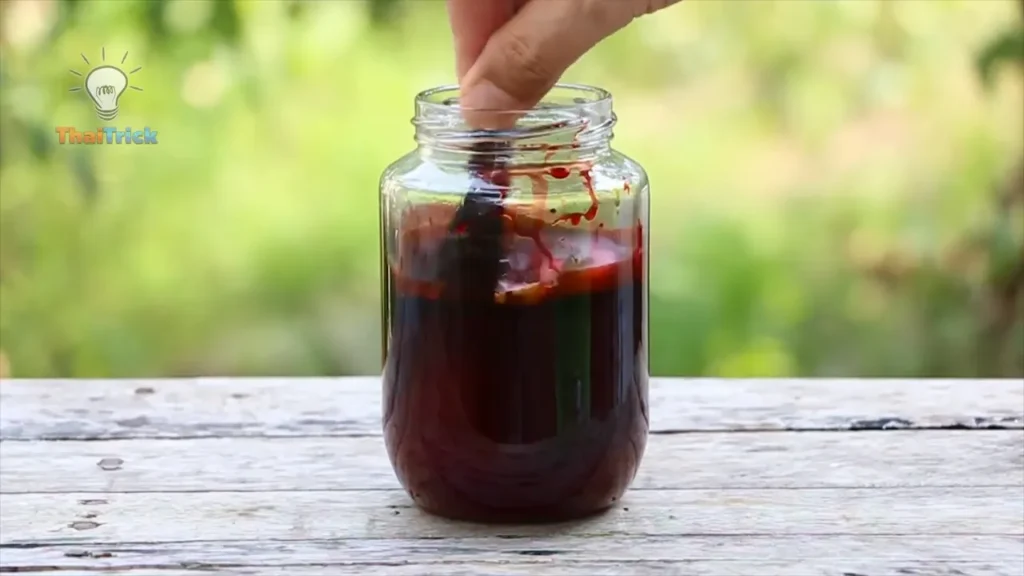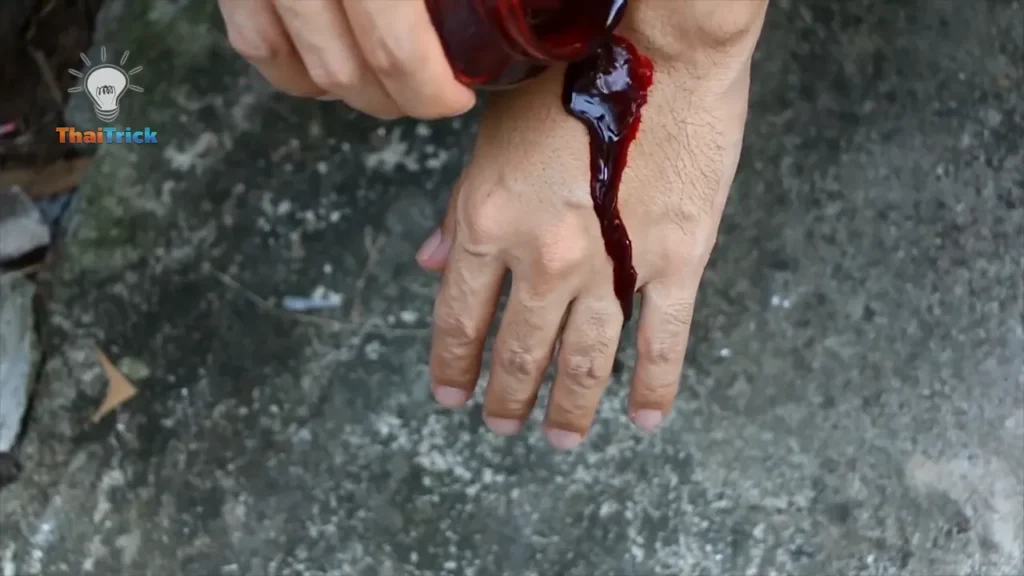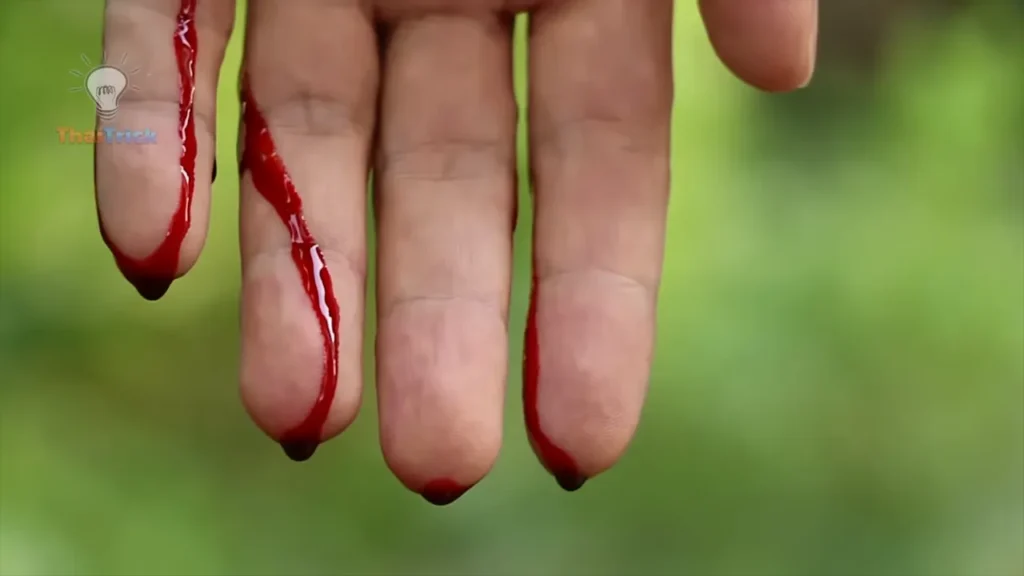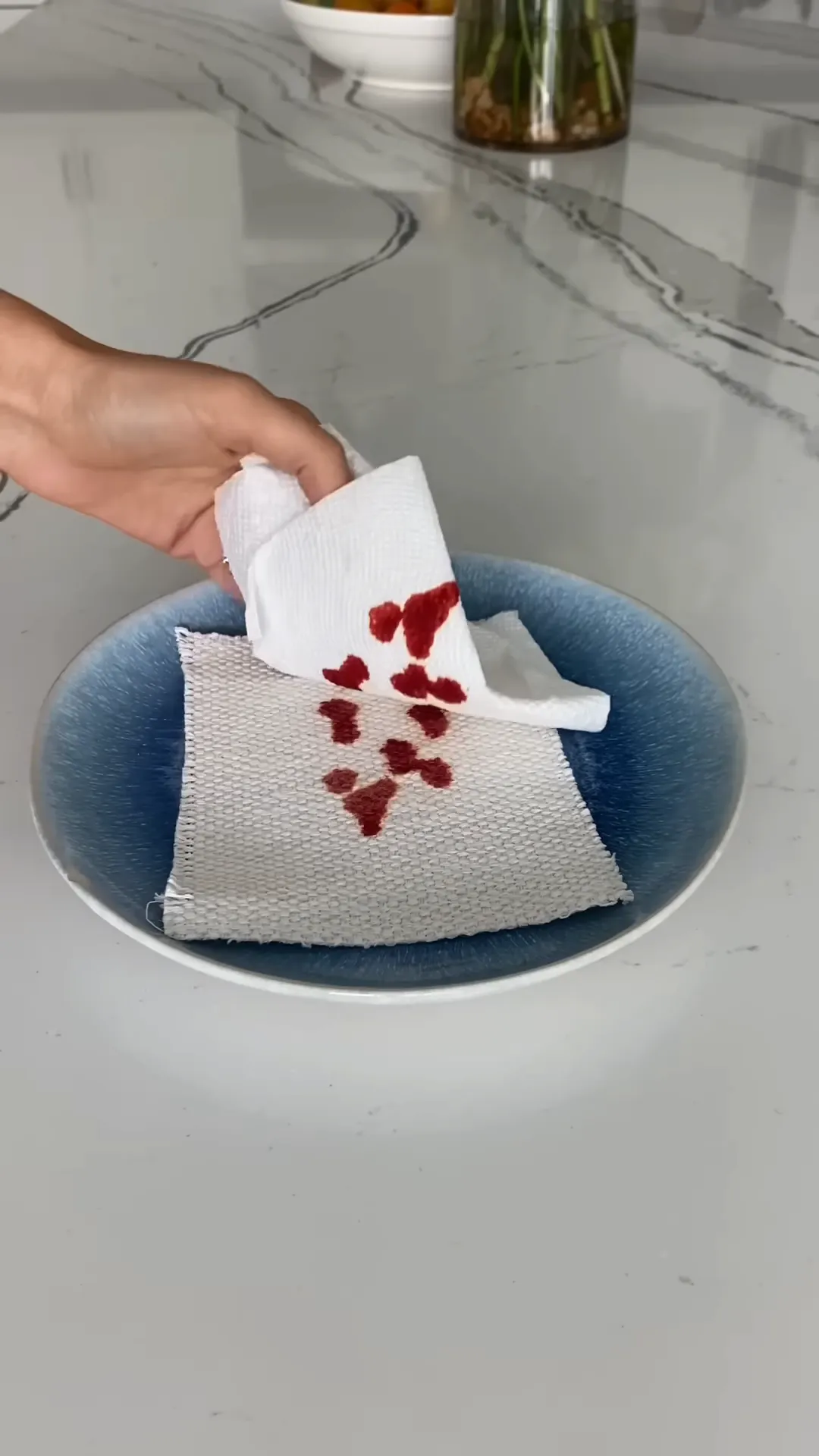Fake blood, a common accessory in theatrical performances, Halloween costumes, and movie sets, often leaves its mark long after the applause has faded. This vibrant, often sticky substance can transform garments into a horror scene, presenting a unique challenge in laundry rooms worldwide. The panic that ensues when this theatrical prop stains your favorite outfit is all too familiar to many.
Will fake blood wash out of clothes? Yes, it generally will, but the success largely depends on the composition of the fake blood, the fabric type, and the timeliness of treatment. Immediate action, combined with the right cleaning approach, can effectively remove these daunting stains, restoring clothes to their original condition.
Dealing with fake blood stains requires understanding their unique properties and how they interact with various fabrics. From homemade concoctions to commercial fake blood, each type has its removal quirks. The key lies in prompt and appropriate treatment, which can make all the difference in preserving your cherished clothing items.
### Importance of Quick Response
When it comes to removing fake blood stains from clothing, time is of the essence. The longer the blood sits on the fabric, the more it penetrates the fibers, making it increasingly difficult to remove. Immediate action can prevent the stain from setting and reduce the likelihood of permanent damage. This urgency stems from the unique composition of fake blood, which often includes ingredients that are notorious for their staining properties.
### Fake Blood Composition


Fake blood used in movies, theater, or as a part of costume makeup is specifically designed to mimic the appearance of real blood. This realism is achieved through a blend of colorants and thickeners, which, while effective on screen or stage, can be a nightmare for fabrics. The composition of fake blood varies, but understanding its common ingredients helps in devising effective cleaning strategies.
#### Common Ingredients
1. **Colorants**: These are typically food dyes or other pigments that provide the vivid red color. Red dyes are known for their tenacity and ability to bind quickly to fabric fibers.
2. **Thickeners**: Substances like corn syrup or gelatin are added to give the blood a more viscous, lifelike texture. These can leave a sticky residue that attracts more dirt and can further set the stain.
3. **Preservatives**: To extend the shelf life of the product, preservatives are often included. These chemicals can sometimes react with fabric dyes, altering the stain and fabric’s color.
#### Stain Properties
The properties of fake blood stains depend largely on their composition. These stains are usually protein-based, making them similar to other organic stains like food or grass. However, the added colorants often behave like dye stains, requiring a dual approach for effective removal.
### Pre-Treatment Steps
#### Initial Assessment
Before diving into cleaning, it’s important to assess the stain:
– **Fabric Type**: Delicate fabrics like silk or wool will need a gentler approach compared to sturdy cotton or synthetics.
– **Stain Age**: Fresh stains are easier to tackle than older, set-in ones.
– **Color Depth**: Darker stains might require more robust treatment.
#### Removing Excess
Start by gently removing any excess fake blood. This step prevents the stain from spreading or seeping deeper into the fabric. Use a blunt knife or a spoon to scrape off solids, being careful not to rub the stain into the fabric.
### Cleaning Techniques
#### Cold Water Rinse
Begin with a cold water rinse. Hot water can cause the stain to set, making it more stubborn. Run cold water through the back of the stain to push it out of the fibers, rather than through the front, which can spread the stain.
#### Stain Removal Solutions
##### Homemade Remedies
For a DIY approach, consider these options:
– **Salt and Cold Water**: Salt acts as a gentle abrasive, helping to lift the stain.
– **Vinegar and Water Solution**: Vinegar, being acidic, can break down the colorants in the fake blood.
– **Baking Soda Paste**: Apply a paste made of baking soda and water, let it sit, then brush it off.
##### Commercial Products
If the stain persists, commercial stain removers can be effective. Look for products that are formulated for protein or dye stains. Enzyme-based cleaners are particularly good for breaking down protein-based components.
### Fabric Considerations
Tailoring the cleaning method to the type of fabric is crucial. Delicate fabrics may require a milder cleaning solution and gentler handling, while more robust fabrics can withstand stronger treatments.
In summary, the immediate and correct response to fake blood stains can make a significant difference in the outcome. Understanding the composition of the fake blood and the properties of the fabric involved helps in choosing the most effective cleaning technique, whether it be a home remedy or a commercial product. The goal is always the same: to return your garments to their original, unstained condition.
### Fabric Considerations
When tackling fake blood stains, the type of fabric plays a crucial role in determining the appropriate cleaning approach. Different materials have varying levels of resistance to stains and react differently to cleaning solutions and techniques. Therefore, identifying the fabric type is a fundamental step in the stain removal process.
#### Delicate Fabrics
Delicate fabrics such as silk, satin, or lace require special care. These materials are prone to damage from harsh chemicals and vigorous cleaning methods. For such fabrics, it’s advisable to:
– **Use Gentle Cleaning Agents**: Mild detergents or solutions specifically designed for delicate fabrics are recommended.
– **Test First**: Always perform a spot test in an inconspicuous area to ensure that the cleaning solution does not damage the fabric.
– **Avoid Scrubbing**: Gently dab the stain with a soft cloth instead of scrubbing, which can fray or damage the fabric.
#### Durable Materials
Durable materials like cotton, denim, or polyester can withstand more robust cleaning methods. These fabrics are generally more forgiving when it comes to stain removal. For these materials:
– **Pre-treat the Stain**: Apply a stain remover or a mixture of detergent and water directly to the stain before washing.
– **Use Warm Water**: Unlike delicate fabrics, durable materials can generally handle warm water, which can be more effective in removing stains.
Can you put fake blood on clothes?
Yes, you can put fake blood on clothes, and it’s often done for various reasons such as theatrical performances, Halloween costumes, or film and television productions. However, there are a few things to keep in mind when applying fake blood to clothing:
1. **Type of Fake Blood**: Choose the right type of fake blood based on your needs. Some fake blood is designed to be washable and easier to remove, while other types are made for longevity and may stain more permanently.
2. **Fabric Consideration**: Consider the type of fabric you’re applying the fake blood to. Some fabrics stain more easily and may not withstand harsh cleaning methods.
3. **Test First**: It’s a good idea to do a patch test in an inconspicuous area of the clothing to see how the fabric reacts to the fake blood, especially if you plan to remove it later.
4. **Application Method**: Apply the fake blood carefully and in a way that suits your purpose. For a more controlled application, use brushes or sponges.
5. **Setting the Blood**: Some fake blood might need to be set with heat or left to dry for a certain period.
6. **Removal Plan**: If you intend to remove the fake blood later, have a plan for how you’ll treat the fabric. Quick and appropriate cleaning methods are crucial for effective stain removal.
Remember, while putting fake blood on clothes is relatively easy, removing it can vary in difficulty depending on the factors mentioned above. If you’re using fake blood for a temporary purpose and wish to clean the clothing afterward, it’s advisable to use a type of fake blood known for being easier to wash out.
Does fake blood dry or stay wet?
Fake blood can either dry or stay wet, depending on its composition and the purpose for which it’s intended. Here are some key points about the drying characteristics of fake blood:
1. **Water-Based Fake Blood**: This type of fake blood usually dries over time. It’s often used in theater or film when a dried blood effect is needed. As the water content evaporates, the remaining components leave a stain or crust that resembles dried blood.
2. **Glycerin or Corn Syrup-Based Fake Blood**: These formulations are designed to stay wet or moist for longer periods. The glycerin or corn syrup in the mixture retains moisture, giving the blood a fresh, wet look. This is particularly useful in film and photography where a shiny, wet blood appearance is desired.
3. **Setting Time**: The time it takes for fake blood to dry can vary based on the thickness of the application, the environment (humidity, temperature), and the specific formulation. Thinner layers in a dry, warm environment will dry faster.
4. **Staining Properties**: Whether fake blood dries or stays wet, it can still stain fabrics and surfaces. Dried fake blood can be particularly challenging to remove because it has had time to set into the material.
5. **Specialized Products**: Some specialized fake blood products are designed to change over time – starting wet and then drying to a crusty appearance, offering versatility for different effects.
6. **Homemade Variations**: Homemade fake blood recipes can have varying drying properties based on their ingredients. For example, a mixture predominantly made of water and food coloring will dry out, whereas adding syrup or gelatin will keep it wetter for longer.
In summary, the drying characteristic of fake blood depends largely on its ingredients and intended use. Whether it dries out or stays wet, it’s important to consider the potential for staining and choose the type of fake blood that best suits the needs of your project.
### Washing Machine Tips
#### Cycle Selection
Choosing the right washing machine cycle is important to effectively remove stains while preserving the fabric’s integrity.
– **For Delicate Fabrics**: Use the delicate or hand-wash cycle with a slow spin speed to prevent damage.
– **For Durable Materials**: Opt for a regular cycle with a higher spin speed to thoroughly clean the fabric.
#### Detergent Types
The choice of detergent can significantly impact the effectiveness of the cleaning process.
– **Enzyme-Based Detergents**: These are particularly effective in breaking down protein-based stains like fake blood.
– **Color-Safe Bleach**: For colored fabrics, consider using a color-safe bleach to help lift the stain without fading the fabric.
### Post-Wash Care
#### Checking Stains
After washing, it’s important to check the garment for any remaining traces of the stain.
– **Do Not Dry the Garment**: If the stain persists, avoid using a dryer, as the heat can set the stain permanently.
– **Repeat Washing**: If necessary, re-treat and rewash the garment.
#### Drying Methods
Choosing the right drying method is crucial to prevent setting the stain or damaging the fabric.
– **Air-Dry Delicate Fabrics**: Lay them flat or hang them to dry naturally.
– **Tumble Dry Durable Materials**: If the stain is completely removed, you can use a tumble dryer on a suitable setting for the fabric type.
### Persistent Stains
In cases where the stain remains after initial cleaning attempts, further measures may be required.
#### Repeat Cleaning
Sometimes, a second or even third cleaning attempt is necessary. For repeat cleaning:
– **Use a Stronger Stain Remover**: Consider switching to a more powerful stain remover or a different cleaning technique.
– **Soak the Garment**: Allow the fabric to soak in a stain removal solution for an extended period before washing again.
#### Professional Advice
If all home remedies fail, seeking professional advice is a wise step. Professional cleaners have specialized techniques and products that can often remove even the most stubborn stains without damaging the fabric.
In summary, effectively removing fake blood stains from clothes requires a tailored approach based on the fabric type and stain severity. Delicate fabrics need gentle care, while durable materials can endure more aggressive treatment. The washing machine settings, choice of detergent, and drying methods are all integral to this process. For persistent stains, repeated cleaning or professional intervention may be necessary. With the right knowledge and techniques, you can confidently tackle fake blood stains, preserving the life and look of your clothing.
### Preventive Measures
The adage “prevention is better than cure” holds especially true when dealing with fake blood stains. Taking preventive steps can significantly reduce the likelihood of stubborn stains, saving time and effort in cleaning later. Here are some strategies to consider:
#### Protective Clothing
Wearing protective clothing is one of the most straightforward and effective methods to avoid fake blood stains. This is particularly important in environments like theater productions or film sets where fake blood is used extensively. Here are some tips for using protective clothing:
1. **Aprons and Overalls**: Wear these over your regular clothes. They act as a shield, keeping most of the fake blood splatter off your garments.
2. **Disposable Wear**: In situations where extensive coverage is needed, disposable gowns or coveralls can be a practical choice.
3. **Gloves**: Protecting your hands is also crucial, as they are often in direct contact with fake blood. Disposable gloves can be a simple solution.
#### Choosing Washable Fake Blood

Selecting the right type of fake blood can make a huge difference. Washable fake blood, designed to be easier to clean, can be a game-changer. When selecting fake blood, consider the following:
– **Water-Based Formulas**: These are generally easier to wash out than oil-based ones.
– **Test Before Use**: Always do a patch test on a small, inconspicuous area of fabric to see how easily it washes out.
– **Read Reviews**: Look for products with good reviews regarding ease of cleaning.
### Recap of Key Points
Reflecting on the insights shared, here’s a quick recap of the key points:
1. **Timeliness is Crucial**: Acting quickly on fake blood stains increases the chances of successful removal.
2. **Understand the Fabric**: Different fabrics require different approaches. Delicate fabrics need gentle treatment, while durable materials can handle more vigorous methods.
3. **Cold Water Rinse**: Start with a cold water rinse to prevent setting the stain.
4. **Homemade Remedies**: Solutions like salt, vinegar, or baking soda can be effective for initial treatment.
5. **Commercial Stain Removers**: For tougher stains, commercial products, especially those with enzymes, are recommended.
6. **Post-Wash Care**: Always check for any remaining stain before drying the garment.
7. **Professional Help for Persistent Stains**: If home remedies fail, professional cleaners can offer more advanced solutions.
### Final Tips and Tricks
In addition to the above steps, here are some final tips and tricks to enhance your stain removal strategy:
– **Be Patient and Persistent**: Sometimes, it may take more than one attempt to completely remove a fake blood stain. Patience and persistence are key.
– **Avoid Heat on Uncertain Stains**: Never use hot water or a dryer until you are certain the stain is completely gone. Heat can set the stain permanently.
– **Pre-Treat Garments**: If you know you’ll be working with fake blood, pre-treat your clothes with a stain repellent to make cleaning easier later.
– **Educate Others**: If you’re part of a team or group, share these tips with them. Collective knowledge can save everyone’s time and effort.
By incorporating these strategies into your routine when dealing with fake blood, you can significantly minimize the risk of permanent stains. Remember, each stain is unique, and what works for one might not work for another. The key is to understand the nature of the stain, the type of fabric, and the most suitable method of treatment. With these tools at your disposal, you’re well-equipped to tackle even the most daunting fake blood stains.
## Frequently Asked Questions
### Can Homemade Fake Blood Stains Be Removed?
Homemade fake blood, often made from food coloring, corn syrup, or beetroot, can usually be removed with household cleaning agents. Prompt treatment with cold water and a mix of mild detergent and vinegar often does the trick.
### Are Commercial Fake Blood Stains Harder to Clean?
Commercial fake blood, formulated for realism and durability, can be more challenging to remove. These stains often require a combination of pre-treatment and specialized stain removers to break down the stubborn pigments.
### Does the Type of Fabric Affect Stain Removal?
Yes, the type of fabric significantly impacts the stain removal process. Delicate fabrics require gentle cleaning methods, while more durable materials can withstand rigorous treatment options.
### Can Fake Blood Stains Become Permanent?
If left untreated for an extended period, fake blood stains can set in and become more challenging to remove, potentially leading to permanent staining. Immediate action is crucial for effective stain removal.
### Are There Any Preventive Measures for Fake Blood Stains?
Using protective clothing or selecting washable fake blood types can prevent severe staining. Pre-treating the fabric with a stain repellent can also provide a protective barrier.
## Conclusion
Removing fake blood stains from clothes is a task that, while daunting, is entirely manageable with the right approach. The key to success lies in prompt treatment, understanding the stain’s nature, and choosing the appropriate cleaning method. Whether dealing with a homemade concoction or a commercial product, each scenario requires a tailored approach, considering the fabric type and the stain’s severity.
In summary, the battle against fake blood stains is winnable. Immediate action, combined with household remedies or commercial solutions, can restore your garments to their former glory. Remember, the sooner you address the stain, the better your chances of complete removal.
Ultimately, the experience of dealing with fake blood stains is a lesson in textile care and the importance of quick response. With these tips and tricks, you can confidently tackle these challenging stains, ensuring that your clothes remain a canvas for fashion, not accidental art.
Learn More!





